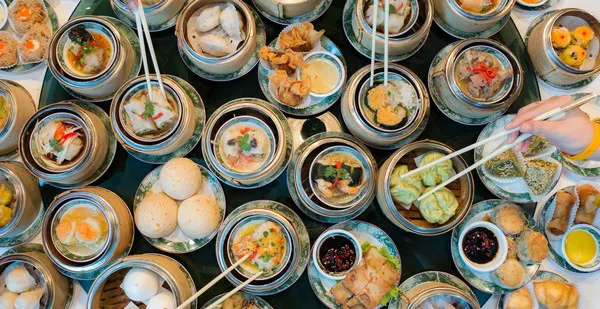Dim sum is a popular Chinese cuisine, especially enjoyed in Cantonese culture. It consists of small dishes served with tea, typically enjoyed during breakfast or brunch. Whether you are new to dim sum or a regular visitor to your favorite dim sum restaurant, it’s easy to get overwhelmed by the variety of dishes available. The number of types of dim sum can seem endless, but each one brings a unique taste, texture, and experience to the table. This article will explore the different types of dim sum, categorized by their main ingredients, preparation methods, and presentation styles.
What Is Dim Sum?
Dim sum, which translates to “touch the heart” in Cantonese, refers to a variety of bite-sized dishes, often served in small portions. It is traditionally served in a communal setting where diners share a wide range of dishes with friends and family. Dim sum includes a variety of steamed, fried, or baked items that feature a wide range of fillings, from savory to sweet. Common dim sum items include dumplings, buns, rolls, and pastries.
Key Categories of Dim Sum
Dim sum can be broadly classified into several categories based on their main ingredients and preparation methods. The following sections will discuss the most common types of dim sum you are likely to encounter when dining at a traditional dim sum restaurant.
1. Dumplings (饺子)
Dumplings are perhaps the most well-known type of dim sum. They come in a variety of shapes, sizes, and fillings, often wrapped in a delicate dough that is either steamed or boiled. Some of the most popular dumpling types include:
Har Gow (虾饺): These delicate shrimp dumplings are one of the most popular dim sum items. The filling is made with shrimp, bamboo shoots, and sometimes water chestnuts, wrapped in a translucent, thin dough. The dumplings are steamed until they are soft and juicy.
Shiu Mai (烧卖): Shiu mai are open-topped dumplings, typically filled with a mixture of ground pork, shrimp, mushrooms, and water chestnuts. They are topped with a small piece of crab roe or carrot to add extra flavor and color.
Chive Dumplings (韭菜饺): This dumpling features a filling made of chopped chives and shrimp or pork. The dough wrapper is green due to the addition of chives, and the dumpling is usually steamed.
Xiao Long Bao (小笼包): These soup dumplings are filled with a combination of seasoned pork and a hot, flavorful broth. When steamed, the broth turns into a rich soup inside the dumpling, providing a burst of flavor with each bite.
Taro Dumplings (芋头饺): Made with mashed taro root, these dumplings have a savory filling that is either sweet or salty. The filling can include ground meat, usually pork or shrimp, and is wrapped in a dough that is fried for a crispy texture.
2. Buns (包子)
Buns are another essential part of dim sum. They can be steamed or baked and are typically filled with a variety of ingredients such as pork, chicken, or vegetables. These buns are soft and fluffy on the outside and filled with savory or sweet fillings. Popular types of buns include:
Char Siu Bao (叉烧包): Char siu bao is a steamed bun filled with sweet and savory barbecued pork. It has a soft, slightly sweet dough that complements the rich filling.
Lotus Seed Paste Bun (莲蓉包): This sweet bun is filled with a smooth lotus seed paste, a traditional ingredient used in Chinese desserts. It’s commonly eaten during dim sum as a sweet treat.
Pineapple Bun (菠萝包): Despite its name, the pineapple bun doesn’t contain pineapple. Instead, it’s named for the crusty, sugary topping that resembles the pattern of a pineapple. It’s a sweet, baked bun often served as a snack.
3. Spring Rolls (春卷)
Spring rolls are another common dim sum dish, typically fried and crispy on the outside with a variety of fillings on the inside. These can be either vegetarian or meat-based, and their fillings vary from pork and shrimp to vegetables and even taro. Some examples include:
Vegetable Spring Rolls: These crispy rolls are filled with a mix of finely chopped vegetables, such as mushrooms, cabbage, and carrots, then deep-fried until golden brown.
Shrimp Spring Rolls: Shrimp spring rolls contain a filling of shrimp and sometimes other ingredients like mushrooms or bamboo shoots. The rolls are wrapped in a thin, crispy dough before being fried.
4. Rice Rolls (肠粉)
Rice rolls are made from thin sheets of rice flour dough that are steamed to create a smooth, soft texture. These rolls are typically filled with savory ingredients and drizzled with a soy-based sauce. Some common types of rice rolls include:
Cheung Fun (肠粉): This dish consists of steamed rice noodles rolled up and filled with a variety of fillings such as shrimp, char siu (barbecued pork), or beef. The rolls are usually served with a sweet soy sauce.
Beef Rice Rolls (牛肉肠粉): These rice rolls are filled with thinly sliced beef, often seasoned with soy sauce and other spices. They are soft and smooth, providing a savory contrast to the rice dough.
5. Steamed Meat and Seafood Dishes
Dim sum is often about highlighting the natural flavors of meat and seafood, whether through steaming or braising. Some of these dishes are simple yet packed with flavor.
Steamed Spare Ribs (蒸排骨): These are small, tender pork ribs that are steamed with black bean sauce, garlic, and other seasonings. They are juicy and packed with flavor.
Steamed Fish Balls (蒸鱼丸): Made with minced fish, these steamed fish balls are light, bouncy, and delicate. They are often seasoned with ginger and served with a light soy-based sauce.
Shrimp and Scallop Dumplings (虾翡翠饺): These dumplings are filled with a mixture of shrimp and scallops, often with a hint of ginger and garlic. The delicate filling is wrapped in a thin dough and steamed to perfection.
6. Fried Dim Sum
Some dim sum dishes are fried to add a crunchy texture, providing a contrast to the soft and smooth steamed dishes. These items are typically served crispy and golden brown.
Fried Taro Dumplings (炸芋头饺): These dumplings are filled with a savory taro paste and deep-fried for a crispy exterior. They are often served with a sweet and sour dipping sauce.
Crispy Spring Rolls: In addition to the typical spring rolls, there are also deep-fried varieties with various fillings such as shrimp, pork, and vegetables.
7. Sweet Dim Sum
While dim sum is primarily known for savory dishes, there are also a number of sweet dim sum options that make for a delightful treat during your meal. These include pastries and desserts that are often served at the end of the meal.
Egg Tarts (蛋挞): These small, flaky tarts are filled with a smooth, sweet egg custard. The filling is rich and creamy, balanced by the light, buttery crust.
Sweet Sesame Balls (芝麻球): These golden-fried balls are filled with sweet red bean paste or lotus seed paste and coated with sesame seeds. They are chewy on the inside and crispy on the outside.
Mango Pudding (芒果布丁): This popular dessert is made with mango puree, coconut milk, and sugar, then set into a jelly-like consistency. It is sweet, refreshing, and perfect for rounding off a dim sum meal.
8. Specialty Dim Sum
Some dim sum dishes are considered to be more specialized or unique. These items often require more skill to prepare and are typically reserved for special occasions or as a treat for regular diners.
Bird’s Nest Soup (燕窝汤): A luxury item in dim sum cuisine, this dish uses the edible nest of the cave-dwelling bird, which is known for its rich, gelatinous texture. The soup is often served with a light broth and sometimes garnished with other ingredients like chicken or mushrooms.
Steamed Abalone (蒸鲍鱼): Abalone is a prized shellfish in Chinese cuisine, and dim sum restaurants sometimes serve it as a steamed delicacy with a soy-based sauce.
Conclusion
Dim sum is a vast and diverse cuisine, offering a variety of dishes that cater to different tastes and preferences. From savory dumplings and buns to crispy spring rolls and sweet desserts, there is something for everyone to enjoy. While the number of types of dim sum can vary depending on the region and restaurant, the dishes mentioned above represent the most popular and widely recognized ones in Cantonese-style dim sum dining. Whether you are a first-timer or a seasoned dim sum enthusiast, the wide range of flavors and textures will always leave you coming back for more.
Related topics:



























